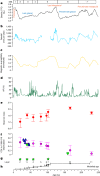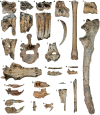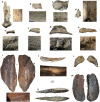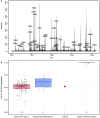Middle and Late Pleistocene Denisovan subsistence at Baishiya Karst Cave
- PMID: 38961285
- PMCID: PMC11291277
- DOI: 10.1038/s41586-024-07612-9
Middle and Late Pleistocene Denisovan subsistence at Baishiya Karst Cave
Abstract
Genetic and fragmented palaeoanthropological data suggest that Denisovans were once widely distributed across eastern Eurasia1-3. Despite limited archaeological evidence, this indicates that Denisovans were capable of adapting to a highly diverse range of environments. Here we integrate zooarchaeological and proteomic analyses of the late Middle to Late Pleistocene faunal assemblage from Baishiya Karst Cave on the Tibetan Plateau, where a Denisovan mandible and Denisovan sedimentary mitochondrial DNA were found3,4. Using zooarchaeology by mass spectrometry, we identify a new hominin rib specimen that dates to approximately 48-32 thousand years ago (layer 3). Shotgun proteomic analysis taxonomically assigns this specimen to the Denisovan lineage, extending their presence at Baishiya Karst Cave well into the Late Pleistocene. Throughout the stratigraphic sequence, the faunal assemblage is dominated by Caprinae, together with megaherbivores, carnivores, small mammals and birds. The high proportion of anthropogenic modifications on the bone surfaces suggests that Denisovans were the primary agent of faunal accumulation. The chaîne opératoire of carcass processing indicates that animal taxa were exploited for their meat, marrow and hides, while bone was also used as raw material for the production of tools. Our results shed light on the behaviour of Denisovans and their adaptations to the diverse and fluctuating environments of the late Middle and Late Pleistocene of eastern Eurasia.
© 2024. The Author(s).
Conflict of interest statement
The authors declare no competing interests.
Figures












Similar articles
-
Denisovan DNA in Late Pleistocene sediments from Baishiya Karst Cave on the Tibetan Plateau.Science. 2020 Oct 30;370(6516):584-587. doi: 10.1126/science.abb6320. Science. 2020. PMID: 33122381
-
A late Middle Pleistocene Denisovan mandible from the Tibetan Plateau.Nature. 2019 May;569(7756):409-412. doi: 10.1038/s41586-019-1139-x. Epub 2019 May 1. Nature. 2019. PMID: 31043746
-
Age estimates for hominin fossils and the onset of the Upper Palaeolithic at Denisova Cave.Nature. 2019 Jan;565(7741):640-644. doi: 10.1038/s41586-018-0870-z. Epub 2019 Jan 30. Nature. 2019. PMID: 30700871
-
The late Middle Pleistocene hominin fossil record of eastern Asia: synthesis and review.Am J Phys Anthropol. 2010;143 Suppl 51:75-93. doi: 10.1002/ajpa.21442. Am J Phys Anthropol. 2010. PMID: 21086528 Review.
-
India at the cross-roads of human evolution.J Biosci. 2009 Nov;34(5):729. doi: 10.1007/s12038-009-0056-9. J Biosci. 2009. PMID: 20009268 Review.
Cited by
-
Combining traceological analysis and ZooMS on Early Neolithic bone artefacts from the cave of Coro Trasito, NE Iberian Peninsula: Cervidae used equally to Caprinae.PLoS One. 2024 Jul 10;19(7):e0306448. doi: 10.1371/journal.pone.0306448. eCollection 2024. PLoS One. 2024. PMID: 38985699 Free PMC article.
-
Quina lithic technology indicates diverse Late Pleistocene human dynamics in East Asia.Proc Natl Acad Sci U S A. 2025 Apr 8;122(14):e2418029122. doi: 10.1073/pnas.2418029122. Epub 2025 Mar 31. Proc Natl Acad Sci U S A. 2025. PMID: 40163722
-
Human, Animal, or Mineral? Ethical Considerations for Studies of Fossilized Hominin Remains.Am J Biol Anthropol. 2025 Jul;187(3):e70085. doi: 10.1002/ajpa.70085. Am J Biol Anthropol. 2025. PMID: 40590317 Free PMC article.
References
Publication types
MeSH terms
LinkOut - more resources
Full Text Sources

